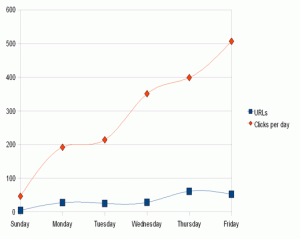I took some quick notes from a couple of sessions this morning – keep an eye out on the Web2Expo site for the slides becoming available.
Business Models for Web 2.0 Companies
Christian Leybold of BV Capital provided a good overview of business models (all advertising) and statistics – sites used as examples during the presentation are BV investment companies)
Opening line that presumably will follow through the presentation – Follow the traffic (and then worry about the money). According to Christian, some 8 of the current top 20 companies in Alexa traffic rankingswere not in it 3 years ago.
Less than 4% of advertising revenues go to the social networks – compared to the traffic these sites get, that’s a pretty small slice. Could virtual items be alternative to ads – incredibly popular example is Cyworld (Korea).
With social networks you cannot afford to spend money in acquiring users, you must have critical mass and you must scale, scale, scale. Gave example of fotolog.com – $12m invested, 12m accounts created so a buck for every single user account. Tiny amount compared to silly times in the late ’90s; clarifies that we don’t confuse investment cost with customer acquisition cost – the latter figure of course is next to zero.
So why is advertising on social networks difficult? You need to know what cusotmer wants NOW! People in social networking mode are not in buying mode; at the same time high repeat users are extremely attractive to advertisers given the profile they are exhibiting.
So how do the leading networks increase ad revenue? Myspace and Facebook are launching today (“Selfserve” and “Pandemic”) solutions for this; very different to google adsense, targeted to usage patterns on the network. While facebook developer platform has been succesful, it is poor in terms of monetization. Summing up – scale audiences are becoming their own ad networks.
What can you do if you are not MySpace and Facebook? Gave example of Glam Media. Buys advertising in bulk from advertisers that fit with the brand. Also Peanut Labs : aggregates “Gen Y” surveys from market research firms. Incredibly, people happy to spend 15 mins filling out survey for a 50 cent reward – people lose track of time when they are online…
Why does Video work online? the fact that you can track via analytics who-watched-what is attractive; video advertising is great for brand awareness; gave all the well known examples of monetisation – pre/psot roll, invideo, promotialal content, sponsorship, search/display advertising, Pay per view. Of course, advertising works best if the content is differentiated and long (no point in a pre-roll on a 1 minute clip). trad. media companies have discovered that it is better to put out popular TV programmes via ad supported model online, rather than using PPV. North of $20 on CPM for video.
Then talked about local advertising – a huge market, but presenting ads in local content skyrockets ad prices (at least 3 times as expense for Adsense local adverts, e.g. restaurant+dublin). So though local advertising is attractive, the cost is prohibitive; local businesses by and large are not familiar with online process and fail to see how they can track and assess how well they are doing. Coupons in local press are where it’s at for them, and what these businesses are familiar with; Getting scale for keywords like “dentist” in local area is very, very tough and very tedious to scale in each market. you could partner with some one elses salesforce, sell some one elses ads, or charge users for premium content. A bit like Angies List -they provide reviews of local businesses, often interviewing people as they leave stores. Then uses a subscription model, often along the way providing coupons from selected businesses; Another provider is Reach Local – they provide a managed service to small businesses for google ads; focus is on easy to understand Ad sucess metrics and reports.
Conclusions – Christian thinks we are on the cusp of seeing ho advertising will REALLY work on social networks. For local online advertising though, it will continue to be difficult.
Designing for a Web of Data Tom Coates of Yahoo is an engaging and energetic speaker and gave a good presentation to a packed audience. My only quibble was that while he had every right to talk about Yahoo product and specifically Flickr, a key theme of his talk – “gather all the data you can” – is probably an easy one to promulgate in the context of online photo storage. Please note that some of this was difficult to capture because some of the messages were contained in the slides (keep an eye on Web2Expo Site/Slideshare) for slides over coming days…
That said – data is the most important thing (echoing Tim O’Reilly here) – the pages are actually less of a big deal in todays web.
Toms 5 key Points of Designing a web for Data
1. You site is not your product
example of twitter – twitterific built around the api; the product is a mechanism for the person to commuicate, but the website is only a tiny part of it; only 10% traffic is generated from it – the rest from the API. this is indication of web data. other examples given pownce, last.fm, etc.
the web of data bleeds into the real world -
- physical object responds to/viduslaised data from the network – eg nabaztag, ambient orb, wattson; all of these are wifi enabled devices sucking data from various sources. also mentioned waeather underground – home weather stations, but also people just entering weather data directly.
2.Play well with others (why it’s good to design for recombination).
Lots of opportunities for your product to do well if you play well with others. why would you open your product?
- drive people to service
- people will pay for them
- as advertising or to put yourself into the ecosystem
- makes your servie more attractive with less central development
The network effects has great potential as a result.
- Examples : map mashups in general – stamen designs do nice stuff.
- talked about Yahoo FireEagle – service about location. currently 50k geotagged location in wikipedia.
3. You can never have too much data (how to make excess manageable).
4. Ways to make a data service
- open up a dataset of your own
- build one with your users
- enhance one dataset with another.
flickr has gone up 500m photos in last 30 days 1.8 billion photos currently. amazing.
capturing metadata
- at production time
- direct analyis of the thing concerned (speech, facial)
- user contributed
- behavioural analysis
5. Hierarchies can not take the weight (from navigation to path finding – from hierarchic to weblike exploration).
Gave examples of redesign of Yahoo UI over the years and Amazon – how you can burrow into the data, coming from different angles;folksonomies and taxonomys can live ok together; top navigation is just a jumping off point; use visual hierarchies to guide user.






![Reblog this post [with Zemanta]](http://img.zemanta.com/reblog_e.png?x-id=c51d2fcf-c933-4bec-9a22-4320417c7402)

